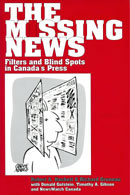
The Missing News
Filters and Blind Spots in Canada's Press
Hackett, Robert A.; Gruneau, Richard; with Donald Gutstein, Timothy A. Gibson and Newswatch Canada
Publisher: Canadian Centre for Policy Alternatives/Garamond Press, Toronto, Canada
Year Published: 2000
Pages: 258pp ISBN: 0-88627-173-8
Library of Congress Number: P92.C3H33 1999 Dewey: 302.23'0971
Resource Type: Book
Cx Number: CX6673
Asks a number of questions, including: How well do the news media filter reality, for what purposes, through what processes and in whose interests? How do newspapers and TV stations choose what news is printed or aired, which letters will be published, or who will be accorded credibility?
Abstract:
The Missing News summarizes the work of News Watch Canada (formerly Project Censored Canada) in researching and analyzing news content and media bias.
The Missing News asks a number of questions, including: How well do the news media filter reality, for what purposes, through what processes and in whose interests? How do newspapers and TV stations choose what news is printed or aired, which letters will be published, or who will be accorded credibility?
The authors have incorporated interviews with Canadian journalists about how they work and the influences that determine what news gets covered in articles and broadcasts. NewsWatch Canada illustrates its points with information gathered from in-depth surveys of news content in Canadian media from 1993 through 1995.
Also given attention is the impact of takeovers and consolidation which swept the Canadian news industry in the 1990s.
The picture that emerges is of a news industry influenced much more by economics and bureaucratic routine than by any overt manipulation, although outright manipulation are not unknown.
More than 80% of surveyed journalists cited too narrow a range of sources as a factor in the omission or underreporting of issues in the news. An equally large majority also said budget cuts and a lack of newsroom resources had played a significant role in narrowing of the scope of news.
News content was scrutinized for bias or slant, using such criteria as which sources were quoted first or most often in articles, seen to have an impact on the credibility conferred on different sides of an issue.
84% of journalists surveyed said a lack of resources, including time, money and news space "occasionally" or "often" lead to the omission of significant news. Downsizing of news reporting staffs means there are too few bodies to cover the basics, let alone stories that stray outside the daily grind of party politics, crime and sports. One result is a tendency for non-routine or complex stories to get ignored or covered inadequately.
Journalists habitually rely on "authoritative" institutional sources, such as corporate PR people, senior officials, the courts, etc. It's more convenient. It's easily digestible, reliable and without surprises. Reporters also reported feeling pressure to write and research stories within certain constraints. The fear of alienating sources, owners or advertisers can create a powerful "internal" self censoring mechanism which can potentially influence which issues get covered and how such issues are framed.
A picture emerges of media outlets dependent on other new producing bureaucracies, and unable or unwilling to allocate resources to independent investigative reporting.
Working to very tight deadlines, and dependent on official sources and access to newsmaking figures, media workers are less likely to risk offending their contacts with stories that may be damaging or embarrassing to them.
Media outlets need a secure supply of usable news as well as a means of processing it efficiently. In addition to supply and production, there are constraints on consumption of news. This is especially true in the case of television news, where there is a need for stories with compelling visuals, and those which can be easily encapsulated to fit the timelines of the medium. This has the effect of narrowing the range of topics that are covered. In order to be economically viable, news must appeal to the reader/viewers' tastes, values and needs, while avoiding offence. This appeal, also known as 'news value", is seen to be directly tied to the profitability and ultimately, the survival of a news outlet. If a story or issue is seen to lack news value, coverage in the media can be expected to be minimal, if it appears at all.
Observable trends in newspaper and TV coverage show an increasing emphasis on "junk food" news about pop culture and entertainment personalities, and more space is allotted to "feature sections", concerned with such "issues" as automobiles and fashion, which further blur the line between information and advertising.
Economic and organizational pressures are cited in the phenomenon of "follow the leader" or "pack journalism" (O.J. Simpson, Diana etc.). Stories that challenge conventional wisdom and are not pursed by other media are likely to be buried. Stories dealing with long term trends are less likely to be covered for fear that the audience may be bored or upset by them.
Table of Contents
Acknowledgments
Foreword, by Peter Desbarats
Preface, by Bill Doskoch
Introduction
Chapter One - Is Canada's Press Censored?
Chapter Two - Paying the Piper
Chapter Three - Journalists Views of the Media
Chapter Four - The Views of Interest Groups
Chapter Five - Searching for Canada's Under-reported Stories
Chapter Six - Patterns of Omission
Chapter Seven - Blind Spots on Labour, Power and Social Inequality
Chapter Eight - Beyond the Blind Spots
Index
Subject Headings


